
|
Jarmila Kaczmarek,
Andrzej Prinke
(Poznań Archaeological Museum)
Two Archaeologies in one Country:
Official Prussian versus amateur Polish activities
in Mid-Western (i.e.: Greater) Poland
in XIXth-early XXth cent.
|
1. Wielkopolska in the first
half of the nineteenth century
(to 1857). Foundations of the creation of two archaeologies
in Poznań |
One
city, two separate archaeologies - Polish and German. Thus it
was in nineteenth century Poznań. For someone unaware of the past
of this part of Poland, which is called Wielkopolska (Greater
Poland), and of which the capital is Poznań, this is not entirely
comprehensible. Is it possible to speak at all of two archaeologies,
since science is not able to subjugate itself to one nation? Being
also aware that already in the nineteenth century the slogan,
"science is international" was well known and highly esteemed,
also in Poznań. And so - why two archaeologies? |
1.1. Political conditioning.
Wielkopolska under the rule of the King
of Prussia. Germanisation of the state (government and officials)
|
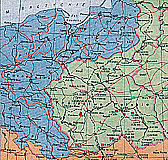
fig. 1 |
The
close of the eighteenth century was a time of progressive loss
of independence for Poland. The result of the internal and equally
of conditions external to its territory, triply divided between
Russia, Austria and Prussia, was an attempt to halt the collapse
of the state ( fig. 1). Such was the appointment
of the Commission of Good Order or the proclamation of one of
the first constitutions in the world; the attempt was made too
late and was fruitless. Wielkopolska greeted the beginning
of the nineteenth century as a |
part of Prussia.
The Prussian state took over the new province severely destroyed
by war and disease (in about 1815 the number of inhabitants of
the Duchy of Poznań was estimated at barely 776,000). Mainly Catholics
lived here, in the majority Poles, but Jews constituted a large
minority and with them, most frequently Protestant, Germans (this
last group present from the thirteenth century, however had been
subject step by step over the years to Polonisation, e.g. the
catholic settlers from Bamberg, arriving in the eighteenth century
in the area of Poznań). The Prussians built their own feeling
of national values and conviction of the civilising mission of
the Prussian state. Seeing on the newly taken terrain Polish gentry
in oriental style sashes, another language, which at times they
referred to as "the rotten local language", another culture and
system of values, they looked on the new country practically as
nineteenth century Europeans at "wild people from the bush" (Łukasiewicz
1995, p. 44), or as the English at Hindus and Chinese. It was
obvious to them that the new country should be civilised and Germanised.
Initially Germanisation meant integration regarding law and politics
with the remaining parts of Prussia, or Germanisation of the state
structure. The Prussian administration, law and legal system were
introduced. In truth from the beginning Germans were favoured,
but the government allowed, that Poles as jointly subjected "brothers
of the Slavonic language" might retain their language and habits.
This did not hinder the many Germans coming to the province, in
their utter conviction of their own superiority, and so it was
obvious to them that soon the Poles would civilise themselves,
which for them was synonymous with adopting the German language
and culture.
From the time of the
first partition of Poland came modest numbers of succeeding German
settlers, taking up then thinly settled land. By about the mid
nineteenth century 40 % of the large estates belonged to Germans
(of these 1/3 were royal estates, and the rest were private one,
taken as a result of i.e. marriage or taking indebted Polish estates).
Whereas German civil servants came to Wielkopolska Province only
for a certain time, after which they returned to Germany.
On the other hand, the
conquered nation, that is the Poles, also did not look with favour
on the new government, regarded by them as occupiers. The upper
and better-educated layer had a feeling of their own values, long
cultural tradition and also valued their own language. Forced
to accept foreign citizenship, they did not intend to accept the
customs and language of the "Partioners". The lower and less educated
classes did not in the beginning have a strong feeling of separate
nationality, but they shared the distaste for the Prussians, whose
army had behaved badly for a hundred years in the conscious experience
of the poor inhabitants of the province. Certainly a cause was
that devils represented in pictures of the eighteenth century
wore Prussian dress - with wig and plaited pigtail. The nineteenth
century rural folk had to accustom themselves by degrees to the
fact that also the officials of His Majesty wore such dress. There
was also the awareness of religious and linguistic separation
(the word German in old Polish means literally dumb). Additionally
in the first years after the annexation of the new province, many
Germans of a sufficiently suspect reputation became administrators
of the new province, who effectively discouraged the new subjects
from possible assimilation. The deeds of government and the mutual
distaste had the affect that from the beginning possible neighbourliness
between both communities and even an improvement of the co-existence
was a difficult problem. Even so cooperation between various sections
of both communities from time to time improved, also leaders of
both nationalities often formed more or less temporary alliances
for defence. There were instances equally of Germanisation and
Polanisation.
In the Napoleonic Wars
some German volunteers from Greater Poland fought on the Prussian
side, whereas the Poles fought on the side of Napoleon. In the
years 1807-1815 Wielkopolska was part of the Duchy of Warsaw formed
by the Emperor of the French. At the Congress of Vienna it was
again subjected to the rule of the King of Prussia, but it was
transformed into a separate Grand Duchy of Poznań, and the king
promised the Poles the maintenance of "political existence" within
the Prussian administrative organisation, he also promised equal
rights for both nationalities.
The defeat of the November
Uprising, which broke out in 1830 in the Russian Partition, was
exploited by the Prussian authorities to abandon the policy of
peaceful co-existence. As soon as 1832 General Grolmann devised
a secret plan, envisaging integration (or Germanisation) of the
province, including forced buying up of estates, colonisation
by German peasants, integration of Jews from Germany, transferring
the Polish gentry and civil servants to other German provinces,
strict subjection of the church to the state and abolition of
the Polish language in schools. The catholic clergy and the gentry
were acknowledged as the most dangerous enemies of Germanisation;
it was assumed that the peasants could be won over to the policy
of the Prussian government. This plan was effected over the next
decade with varying determination, hence periods of repression
interwoven with periods of liberalisation.
From the third decade
of the nineteenth century, one may observe the first symptoms
of the Wielkopolska community organising itself, during which,
generally the Germans had less problems with the establishment
of organisations of a German character, whilst the Poles in general
had to fight hard to establish their own. For the government regarded
them, certainly correctly, as a symptom of Polish defence against
Germanisation.
Finally by about the
mid nineteenth century in Wielkopolska the inhabitants were around
70% Poles, 5% Jews and 25% Germans (plus civil servants temporarily
in the province). Of the 44 thousand population of the city of
Poznań itself, the Poles made up 50%, and the Jews and Germans
25% each (but 75% of the land belonged to the Germans). |
1.2. Beginnings of
the interest in archaeology among the Poles of Wielkopolska |
In
all three Partitions the loss of independence, which could not
be countered, gave rise to a desire among the educated classes
to save reminders in full glorification of the past, equally the
historical ones as those won from the soil. In Wielkopolska Province
this was limited initially to the accumulation of private collections,
and that activity increased after the Napoleonic Wars. During
the following years small collections of items dug up on the terrain
of their own possessions or of friends became frequently the attribute
of manor houses and presbyteries (i.e. the Węsierski family from
Zakrzewa in 1819 and the Działyński family from Kórnik - 1838).
Archaeological historic remnants treated as one's own traces -
the Polish past, according to the view of the outstanding historian
of the nineteenth century, Joachim Lelewel, that "such a great
nation did not come from anywhere, but developed in its place",
therefore the Slavonic forebears had to settle on the Baltic coast
and the Vistula "shortly after the Flood" (and the confusion of
languages at the tower of Babel).
An expression of the
national sentiments was the initiatives, intended to form Polish
organisations of a cultural character, amongst them organisations
engaged in archaeology. Around 1827 Dr. Antoni Kraszewski together
with other Poles attempted to establish the Association of Friends
of Science in Poznań. Finally in 1830 the Prussian government
refused registration, for among other reasons the envisaged use
of Polish at meetings, which was regarded as a symptom of discrimination
against the German speaking part of the population.
However beyond Poznań
in the third decade of the nineteenth century there existed periodically
organisations engaged in archaeology, named "Casinos". Archaeological
collections were possessed by among others, the casino in Gostyn,
assembling beside Poles equally Germans, as in Szamotuły, where
the Society of Collectors of National Ancient Artefacts worked
through the casino. Meanwhile the endeavour to catalogue the fortified
settlements was initiated, investigations conducted concerning
archaeological sites, care was taken over the method of investigation
and the drawing up of documentation. Organisations and collections
endured till the Spring of the Peoples (1846), after which, the
collections were scattered.
In the first half of
the nineteenth century in Wielkopolska the first, still few, archaeological
publications appeared in the Polish language (papers in journals:
Mrówka Poznańska, Przewodnik Rolniczo-Przemysłowy or Przyjaciel
Ludu). Also the first translation into Polish took place of a
foreign language work devoted to ancient Slavonic culture (by
Slovak Szafarzyk, 1842). The first Polish questionnaire appeared
also concerning archaeological searches. Wincenty Pol from Cracow,
who turned to Jakub Krauthofer from Poznań with the appeal to
gather the ancient artefacts of the country and transfer them
to Kraków. Krauthofer at that time published in Goniec Polski
the manifesto (MAP-A-dz-36/1), together with instructions, in
order to draw attention to names of a local character: fort, grave,
mound, sorrows, bitter place, stronghold or castle. He proposed
the gathering of artefacts from battlefields, the recording of
traditions and folk songs. He appealed that after archaeological
diggings at a site that the site might be restored to its original
condition and left for future generations as a place "sacred and
untouchable". The artefacts obtained might be sent to Kraków with
the aid of the author. |
1.3. Beginnings of
the organisation of German protection of historical objects |
In
the first half of the nineteenth century the inhabitants of the
German provinces were not interested in the past of Wielkopolska.
The peasants irrespective of nationality were at most only interested
in history in the sense of biblical history and local legends,
the German merchants and traders were absorbed in their own affairs,
the landowners of great estates were few, civil servants were
in the province for a short enough time and for them the province
had a Polish past and therefore not worthy of any sort of interest.
The protection of historic objects was taken up however by the
Prussian government, which gave various rulings in these cases,
beginning in 1815. Attempts at introducing regulations concerning
the protection of historic objects in Poznań received no support
from German officials living in the province - those who were
responsible for undertaking that protection.
Such an example was
the case of the German inspector Gaul, who was obliged in 1824,
to draw up in 6 weeks an inventory of "old works of art, monuments
and historic remains worthy of attention" for the purpose of extending
protection to them, finally filed a statement after several years
and many reminders, that "within the extent of his building jurisdiction
there are no monuments of old architecture". The German government
in truth considered that one could never lack buildings worthy
of attention (MAP-A-dz-2/1), but for Gaul it was obvious, that
only German historical monuments were worthy of protection, and
in the province such he had not yet seen.
Certainly an exception
from either rule was the activity of the German pastor, Wunster,
a very energetic keen historical enthusiast co-operating with
Prof. J. Büschingiem from Wrocław, who seeking in 1824 in Greater
Poland (Pawłowice, Krzemieniewo locality) Phoenician trading posts
on the "Amber Trail", considered all traces of settlement as evidence
of "our", or the German Fatherland (MAP-A-dz-2/1), deeds. Yet
it seems that this conviction is only a mechanism borne out by
a native German, where all traces of the past are regarded as
one's own.
In succeeding years
the Berlin government consequentially widened the area of protection
of ancient monuments and when on the 27th of March 1835 the Department
of Internal Affairs of the Government of the Kingdom pronounced
a decree concerning the protection of archaeological relics, attaching
proper methodology instructions, it reached Wielkopolska officials
as well. German officials conducting any excavation had to collect
all items found, prepare protocols on the work undertaken and
send everything to Berlin. There it was placed in the Fatherland
Museum in the Monbijou Castle (Kostrzewski 1949, pp. 20-25), where
it was described as a "Slavonic" historic relic. In 1836 the Poznanian
Germans founded the Kunstverein - Arts Society, of which practically
half of the members were Poles. On the 1st of July 1843 the office
the General Conservator of Historic Relics in Berlin was established,
but in Poznań there was still for a long time nobody, who might
be exclusively designated as being responsible for the protection
of relics, or at least for the coordination of these activities
in the territory of the province.
When in 1842 the German
authorities in Poznań took the initiative of establishing in Poznań
institutions to collect artistic relics, and equally some archaeological
relics, it did not succeed in assuring this venture any source
of finance or government support (Kaemmerer 1904, p. 36). The
Ministry of Public Education and Enlightenment explained though
that in the vicinity there are other museums. These museums "in
the vicinity" were in fact located in Brandeburgian Berlin (250
km), Silesian Wrocław (170 km) and in Pomeranian Szczecin (200
km). It is worth remembering that when the Berlin government made
this pronouncement, Poznań did not have any railway line; one
had to use stagecoaches or one's own transport. |
| 2. Wielkopolska Province in
the years 1857-1918 |
2.1. Political conditions
of the existence of two archaeologies in the second half of the
nineteenth century |
By
the mid nineteenth century it was ever more apparent that the
hope for a rapid "self civilisation" of Wielkopolanians by willing
Germanisation had been fulfilled to large extent only in relation
to the Jewish minority (Grześ, Kozłowski, Kramski 1976). The result
of government policy, ever more favouritism of Germans (and the
Evangelist persuasion) and discrimination against Poles (and Catholicism),
in the mid nineteenth century ever less attempts were made at
peaceful coexistence between both nationalities. In exchange the
national, religious and cultural separateness of Poles and Germans
began to be accented. The Poles succeeded in founding in 1857
the Poznań Society of Friends of Science (Towarzystwo Przyjaciół
Nauk Poznańskiego - TPNP) and other cultural institutions such
as the theatre in Poznań. One of the landowners of the Wielkopolska
Province, the Pole, Edward Raczyński, donated to the city a large
library (which however the Prussian authorities succeeded in Germanising).
In order to better resist economic pressure Poles organised their
own agricultural education, established banks, and societies of
an economic nature. This activity was already perceived half way
through the sixth decade of the nineteenth century by the provincial
government as a threat to the future.
From 1858 the Germans
took up the idea of the unification of Germany under the Prussian
aegis. For Wielkopolska Province it meant an intensification of
the policy of Germanisation and increasing the privileges for
Germans. The final purpose was the Germanisation of society by
the elimination of the Polish language and culture. The Germanisation
of elementary schools was begun, though it proceeded with difficulty
because of the lack of sufficient numbers of teachers knowing
the German language. In 1867 the Grand Duchy of Poznań was incorporated
into the North German Union.
The victory over France
in 1871 caused an increase of nationalism in Germany. From then
the Germanising of Greater Poland meant the dislodging and paralysing
of the "Polish element" (mainly gentry and clergy as the most
aware opponents). Combating opposition against unification, Chancellor
Bismark declared the policy known as the Culture Battle. In 1872
schools of a religious persuasion were closed, and the state took
up the supervision of education. The estate of the Church was
transferred to the supervision of laypersons, monastic orders
were dissolved, and the paragraphs of the Prussian constitution
assuring the freedom of the Catholic Church were removed. In Wielkopolska
the Culture Battle took on a nationalistic and sectarian character.
Mainly specially chosen teachers and officials were engaged in
Germanisation, there was even a fund for prizes for Germanisation
results.
When at the end of the
'seventies the Culture Battle action became milder, this did not
apply to Wielkopolska. The failure of Germanisation caused the
German philosopher E. Hartmann in 1885 to proclaim the slogan
- eradication of Slavs on the German territory. The President
of the Bydgoszcz Regency, Tiedemann, in 1886 prepared a new Eastern
policy programme: Denkschrift betr. einige Massregeln zur Germanisierung
der Provinz Posen. During which, he drew attention to the fact
that ordinary German inhabitants of the province were unwilling
to engage till now in the propagation of Germanness, for they
felt uncertain and alien in Greater Poland. The conviction of
centuries of settlement in Wielkopolska was to give the German
inhabitants self-assurance and convince them of the correctness
of elimination of Slavs from the province terrain.
In 1886 the Clearance
Commission was established to buy up Polish estates. The funds
of the Commission were continually increased over the following
years, but the final effect was poor. In truth it had succeeded
in increasing the overall number of Germans in the province; however
the number of Poles as a result of higher natural increase had
increased still more, especially on the towns. The price of colonisation
was also high; the creation of one German farm cost the government
and taxpayers (equally the Polish) 60,000 marks (for comparison
a labourer for physical work in Poznań was paid 0.3 marks per
hour). In the following years the Polish language was completely
abolished in ordinary schools (with the teaching of religion),
which provoked strikes by Polish children, quelled by beatings.
After a short period
of thaw in the years 1890-1894, the government returned to the
policies of forced Germanisation. In 1894 on the initiative of
German landowners - Hansemann, Kennemann and Tiedemann, the Organisation
for the Propagation of Germanness in the Eastern Borders (Verein
zur Förderung des Deutschtums in den Ostmarken) was established,
called for short Hakata, after the first letters of the surnames
of the founders. The organisation demanded the abolition of the
use of any Polish at all from schools, the prohibition of the
use of Polish at meetings and the closure of Polish newspapers.
It joined the struggle for forcing through the proclamation of
new laws on evicting Poles and bringing in Germans. In 1904 the
settlement law was changed from the aspect of the battle with
the greatest threat to German culture - Polish peasants. In 1908
the law of forcible buy out of Polish estates for the needs of
German colonisation was announced (it came into force from 1912
to 1914, only 4 estates were expropriated). In order to completely
stop the Polish parcelling out of land, from 1914 the government
introduced first right of purchase (for the government) and of
granting consent for subdivision by local authorities.
The policy of discrimination
against all classes of Polish society and the Catholic Church
caused the acceleration of the process of developing the sense
of national awareness among the Polish peasantry, consolidation
of all classes of Poles and a growth of anti German bias among
them. In the struggle to endure Poles had to learn good organisation
and managed to effectively resist Germanisation. The slogan brought
forth in the time of the greatest intensification of economic
pressure "Your own to your own by your own" not only had an economic
note, but also a cultural one. On the other hand, the permanent
increase by the government of the privileges of German inhabitants
often fuelled a sense of menace for the Poles and the bringing
in of anti Polish orientated officials caused a growth of anti
Polish feeling among the Germans. In this situation, in spite
of periodic attempts at cooperation, also in science, including
archaeology, Poznań began to have two faces - Polish and German.
|
2.2. The years 1857-1885.
The attempt at Germanising society. The advantage of Polish archaeology
over German in Poznań
2.2.1.
Polish archaeology 1857-1885
In the difficult times
of German pressure archaeology became one of the elements of Polish
struggle to maintain their own identity, culture and language.
Their domination in Wielkopolska archaeology between 1857 and
1885 was facilitated by the practically complete extinction of
the official Prussian archaeological recovery and the sufficiently
general conviction then among Germans, that archaeological relics
found in Wielkopolska Province are Slavonic and not worth protection
or interest.
For the increase of
interest in archaeology among Poles in Wielkopolska the establishment
in 1857 of the already mentioned Society of Friends of Science
had great significance. It was a Polish organisation, which was
to propagate science in the Polish language. among the 42 founders
there was also one German - Ludwik Koenigk. The prohibition of
the Prussian government concerning the joining of a Polish society
by the most educated level of Wielkopolska society that is officials
and teachers caused the work of the History Department to be based
mainly on the work of amateurs.
The Museum of Polish
and Slavonic Historical Artefacts operated through the Society
from the beginning (fig. 2, 3).
Among the tasks of the Museum was the collection of archaeological
relics recovered mainly from cemeteries, items of pagan cults
(i.e. statues of gods) weapons and equipment of the Middle Ages
and later, memorabilia of famous people, coins, medals and works
of art. Supervision over the collections was entrusted to the
secretary of the Society, whilst the custodians (called the conservators
of the collections) were successively: the teacher Maksymilian
Studniarski, the master chef Albin Gorecki and the journalist
Władysław Wierzbiński. |
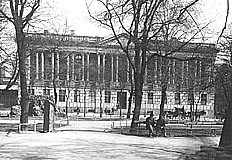
fig. 2 |
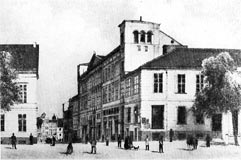
fig. 3 |
The
museum collections rapidly increased because of donations and
as early as 1858 they were exhibited at the exhibition of historical
artefacts in Kraków, and in 1861 - in Lwów. The same year saw
the appointment of the four member Archaeological Commission (Antoni
Białecki and Kazimierz Szulc worked in it among others), but many
other members of TPNP also concerned themselves with archaeology
(e.g. J. N. Sadowski, Leon H. Chlebowski, J. Przyborowski, H.
Feldmanowski). The Commission did not work long, but in that time
succeeded in examining several archaeological sites (among others
at Dobieszewko, Włościejewki, Chwałkowo and Manieczki). In 1863
it was attempted to organise an exhibition of "the occasion of
the thousandth anniversary of the introduction of Christianity
into the Polish lands and the rule of the Piast family in Poland".
The project was not carried out because of the outbreak of the
January Uprising in the Russian Partion (Kaczmarek 1996, p. 59).
In the first years of
the existence of the Poznań Society of Friends of Science the
collection had a great exhibition value; its scientific value
was significantly less. Together with the taking over in 1868
of the position of Conservator of Historical Artefacts by Hieronim
Feldmanowski, teacher and writer began a period of attempts to
assure the collections a scientific position. H. Feldmanowski
put the collections in order, and led the work at the digs himself.
|
Because
of local difficulties in 1872, with the money of Count Seweryn
Mielżyński a house on Młyńska Street was purchased and the following
years were dedicated to its extension and rebuilding ( fig.
4). In 1874 a delegate of the Society participated in the
archaeological convention in Kiev, however provoking the condemnation
of the Polish press (treated as collaboration with the occupier).
In 1878 an appeal was sent to landowners, that all historic artefacts,
especially those dug up, be transferred to the Poznań Society
of Friends of Science. The Archaeological Commission was reactivated |
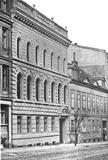
fig. 4 |
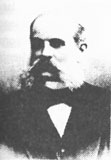
fig. 5 |
a year later under the management
of W. Jażdżewski; also Hieronim Feldmanowski, Ignacy Szafarkiewicz,
Kazimierz Szulc, Adolf Moszczeński and Klemens Koehler ( fig.
5) worked in it. The Commission worked actively only till
1883. In 1880 under pressure from the Prussian government the
Society took part in the Berlin anthropological-archaeological
exhibition sending it 387 artefacts.
In 1882 a new Conservator
of Collections (Klemens Kantecki) was appointed, but the retired
H. Feldmanowski continued to be responsible for the archaeology,
together with W. Jażdżewski he arranged the artefacts in groups,
but without |
description. Also in 1882 the first exhibition
open to the public was opened, with captions in Polish and German.
The number of visitors in the first year amounted to 1172 persons.
The exhibition was only open on Sundays and on other days by prior
appointment. The opening of that exhibition shook deeply the conviction
of their own superiority of many Germans. In following years prehistoric
relics were listed in the museum, the first catalogue was arranged
and drawings were made. In 1884 the Society of Friends of Science
participated in the archaeological convention in Wrocław, exhibiting
relics from the Bronze Age. Kazimierz Szulc presented a paper
at it On the prehistoric inhabitants of the countries between
the Vistula and the Elbe (O przedhistorycznych mieszkańcach krajów
między Wisłą a Elbą).
The Society maintained
itself exclusively from the gifts of the Polish community, who
not being able to rely on the state for support for their cultural
aspirations showed great generosity. As an organisation working
in such difficult conditions the Society had amazing achievements
in the field of collecting archaeological collections and conducting
scientific digs. For this it was grateful to three factors: the
wisdom of succeeding conservators of the collections, the support
of the most enlightened level of society in Greater Poland and
the activity of the specially appointed Archaeological Commission.
Among the greater achievements of the Poznań Society of Friends of Science were:
1) assuring a sufficiently stable, though very modest, material
basis for activity (obtaining private sponsors and a large number
of members);
2) conducting among the Poles collection donation campaigns, including
archaeological, to the TPNP Museum, in order to be available for
scientific examination, due to this by the end of the nineteenth
century it was estimated that the Society had the largest archaeological
collections amongst all the scientific societies in Germany. From
the beginning of the 'seventies a catalogue of the collections
was established, though it was necessary to wait longer for an
inventory.
3) publication of there own magazine in the Polish language, where
beside the sources and historical studies there were often also
reports on examination of sites and discussion on the condition
of examination of the archaeology of ancient societies. Periodically
the Archaeological Commission also published special Poznań Archaeological
Notes (Zapiski Archeologiczne Poznańskie - fig. 6,
7) in Polish and German versions. Historians
and archaeologists from the Austrian Partition were also interested
in the archaeology of Wielkopolska and at the behest of the Archaeological
Commission of the Polish Academy of Humanities in Kraków in 1877
Jan Nepomucen Sadowski prepared a register of relics from the
Warta and Barycza river basin (materials for an archaeological
map). He also took up the trade routes of the Greeks and the Romans
(Sadowski 1877). |

fig. 6 |
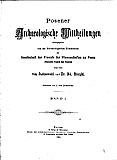
fig. 7 |
4) conducting their own examination of dig
sites, at times within the scope of the Archaeological Commission,
at times under only the name of the Society. These works were
carried out not only with the consent of the owners of the land,
which was obvious, but also for their money. Information was noted
on the circumstances of find, at least the name of the place where
a given item had been found and a short description of the position
and definition of the type of examined objects, approaching typology
of discovered objects. Only at times did it occur that a site
was examined, the level of which significantly exceeded the normal
standard. Among these was the excavation of Antoni Białecki -
a 20-year-old trainee on the estate of Count Chłapowski - undertaken
at Manieczki in 1857. In all textbooks of the history of archaeology
the high standard of documentation and publication of the examination
results of this location is underlined. The second location examined
at a high scientific level was the early medieval fortified settlement
at Pawłowice. This object was examined by the TPNP conservator,
Hieronim Feldmanowski, an educated person; he knew the instructions
for concerning the conducting of excavations, which every so often
were published by the German government, and which were good methodology
guides.
The Society also did
not avoid discussion on the Slavonic origins. As early as 1857
there was consideration of the theory supporting equally Slavonic
auto and allochtonism (i.e. Wojciech Konewka (MAP-A-dz-36/1),
a Polish inhabitant of Rugia on the origins of the inhabitants
of the island). Karol Szajnocha published in Lwów the work The
Lechicki Polish Beginning (Lechicki Początek Polski), in 1858,
in which he advanced the hypothesis on the influence of the Norsemen
on the rise of the Polish state, and from that time ever more
people doubted the possibility of ascribing to the Slavs all the
finds in Poland. On Slavonic autochtonism agreement was virtually
general, however there were continuous theoretical discussions,
without indication of actual relics, especially, as both Poles
and Germans were warned against hasty ethnic identification from
relics by the anthropologist Rudolf Virchow from Berlin. There
was participation in the sometimes stormy discussion on the accuracy
of the system of Three Epochs, making use of the theory of evolution
in primeval times and on the relationship between archaeological
discoveries and Biblical chronology. At times it was also attempted
to link effected discoveries with known literary sources and legends.
Even though having their
own large collections, the archaeological enthusiasts concentrated
around the Poznań Society of Friends of Science did not create
their own system for the primeval history of Wielkopolska. They
had no such possibility: not having the chance of employment in
education or public cultural institutions, Wielkopolans preferred
technical and natural or maybe even medical studies. Through all
the years also in TPNP the archaeological collection was treated
as evidence of the full glory of the Polish past, the more so,
that for a long time it was not possible to date the finds nor
to ascribe them to a specific ethnic group. It was only later
that endeavours were made to give the collections scientific values.
2.2.2.
German research 1857-1885
Even though German interest
in the past of Wielkopolska was slight, also among them at the
latest from the 'seventies there was an increase in interest in
archaeology. They were on the one hand individually interested,
but also convinced that for the moral of the community it is not
irrelevant whether the nation originated from Asia, or occupied
the land that they now possess (Kmieciński 1991, pp. 72-83). Small
collections started (MAP-A-dz-2/2). The Berlin anthropologist
Rudolf Virchow possessed private excavated collections. In 1874
Wincent Zentkeller, a teacher at Ostrów Wielkopolski secondary
school wrote a study in German devoted to discoveries in the Province
of Poznań. Several years later Albin Kohn co-wrote a work on archaeological
discoveries on the territory of former Poland. An eminent figure
at that time was in the area of archaeology was Wilhelm Schwartz,
director of the Poznań Friedrich Wilhelm secondary school (MAP-A-dz-2/3).
Both he and the school run by him had archaeological collections.
Schwartz also lectured in archaeology, corresponded with learned
people all over Europe and published the results of his findings.
He himself conducted numerous excavation examinations at a very
respectable level. Schwartz endeavoured to put into practice the
conviction of the international character of science and in order
to prepare the earlier mentioned map went into cooperation with
the Poznanian Society of Friends of Science. He even offered several
items to the Mielżyński Family Museum. In 1874, based on the support
of TPNP, he published an appeal to all inhabitants of the province
for information, attaching a good questionnaire. Schwartz published
the information gathered in 1875 in Materialien zur prähistorischen
Kartographie der Prov. Posen, (Zusammenstellung der Funde und
Fundorte) - Beilage zum Programm des Königl. Fr. Wilh. Gymnasiums
in Posen. During this time learned people maintained improved
relations with the Poles, exchanging experience and conducting
research on their estates. When in 1883 Schwartz was transferred
to the Luisa secondary school in Berlin, he left students in the
province interested in archaeology, among them his own son. These
students later took part in the propagation of Germanism, organising
a German museum and supporting the already mentioned Hakata. With
the departure of Wilhelm Schwartz ended the short period of friendly
Polish-German cooperation in archaeology in Poznań and the long
period of rivalry started. |
| 2.3. The years 1885-1918. Time of fierce
rivalry |
In
the years of the 'eighties, in connection with the German programme
accelerating the Germanisation of Wielkopolska, the learned gave
more attention to these lands. The hope was born, that archaeological
and anthropological science might unambiguously clarify the question
of the settlement in prehistory by Slavs or Germans of the lands
up to the Vistula, which with the project to evict Poles from
these provinces was not without significance. In Wielkopolska
at this time two parallel theories were advanced: the autochtonism
or migration of the Slavs, the first proposed mainly by Polish
scholars living in the Austrian Partition, and the second by the
majority of Germans from outside Wielkopolska. The Prussian government
appreciated the significance of archaeology (also in politics)
and from 1886 gave a series of decrees concerning the protection
of historic relics. The greatest achievement of the Prussian government
in the area of protection of historic relics was the law on excavations,
only proclaimed in 1914. It was very modern and sensible, though
simultaneously by the ill will of officials gave the chance to
take Polish collections in the future.
The opening of the permanent
exhibition by the Polish Mielżyński Family Museum in 1882 placed
the Germans in a very awkward situation, which they could not
long tolerate, since it invalidated the theory of the cultural
superiority of Germans over Slavs. Finally in 1885 a competing
German Historical Society of the Poznań Province (Historische
Gesellschaft für die Provinz Posen - HG) was founded, the main
purpose of which was to establish a Provincial Museum. This was
achieved in 1894; the Museum took over the HG collection and immediately
proceeded with the appeal for the integration of all Poznań collections.
The idea was appropriate, yet in the conditions in Poznań it would
mean the removal of the basis of Polish scientific research and
their achievements over many years to the gain of the Germans.
So the Poznań Society of Friends of Science protested and it was
possible to save the existence of the Mielżyński Family Museum.
Both Poznań Societies
and later Museums regarded each other with distaste. From necessity
actually at times in achievements local competition or cooperation
was used, but unwillingly acknowledged publicly. It was somewhat
different at the times of conventions of German scientific organisations.
When in 1888 the Historical Society of the Province of Poznań
organised the German National Convention of Historical and Antiquarian
Societies, its participants visited the exhibition of the "competition"
and were amazed by the dimensions, variety and order of the museum
collections. |
A
second example of cooperation occurred - strangely - at the time
of the greatest pressure for the Germanisation of the province.
In 1909 the 40th anniversary Congress of the German
Anthropological Society was organised in Poznań. It was organised
jointly by both museums, which was concealed officially. In the
"Honorary Section" of the Congress the TPNP chairman - Bishop
Likowski - represented the Poles. The "Executive Section" worked
under the leadership of Ludwig Kaemmerer, the director of the
Kaiser Friedrich Museum, and was composed equally of Germans
(e.g. Erich Schmidt from |
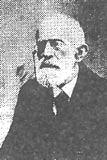
fig. 8 |

fig. 9 |
Bydgoszcz, Georg Haupt and Erich
Blume from the Kaiser Friedrich Museum or Adolf Warschauer) and
Poles (e.g. Franciszek Chłapowski ( fig. 8)
from TPNP, Bolesław Erzepki ( fig. 9) from
the Mielżyński Family Museum and Zygmunt Zakrzewski). The work
was divided so that the achievements of the province should be
impressive. The Kaiser Friedrich Museum undertook the organisation
of the pre-historical exhibition, while Mielżyński Family Museum
organised the ethnic exhibition. Excursions were arranged for
the members of the Congress: one to the surroundings of Poznań,
the second |
to the so-called "Russian Poland", swinging
through the Austrian Partition. The guides were Polish and German,
and Polish scientists worked in the museums. Both Poznań museums
were visited (MAP-A-dz-8/1-2).
Equally the area of
operation of HG, and Provincial Museum might be described as a
time of equilibrium between both archaeologies. In truth the German
institution had a markedly better financial base, and the support
of the government assured them excellent cooperation with schools
and government offices, yet the Polish archaeology made up for
this by a higher level of scientific |
research. Not until the opening
of the Kaiser Friedrich Museum ( fig. 10)
in 1903-1904 did the scales tip in favour of the Germans. From
1908 the Museum employed archaeologists, who introduced new organisation
and research methods, which combined with large finance and the
beneficial for KFM act on excavations had the effect, that the
private the Poznań Society of Friends of |
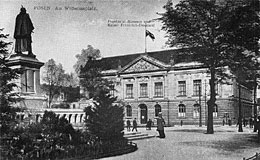
fig. 10 |
Science was unable to equal them.
The next danger for
the Polish museum arose in 1913 when the Prussian parliament began
to complete the preparation of the law on excavations (passed
in 1914). At the time due to a member of the Polish Circle in
the Prussian parliament, Idzi Świtała, it was possible to take
care that the form and interpretation of the law would assure
the right of existence to Mielżyński Family Museum.
The advantage of the
German archaeology over the Polish did not last long. Together
with the outbreak of the First World War in 1914 the German archaeologist
Johannes Richter was called up into the army. When he returned,
the Wielkopolska Uprising broke out and the Museum ceased to exist
as a German institution.
2.3.1.
Polish archaeology 1885-1918. equilibrium (1885-1903), struggle
for survival
(1904-1914), time of Polish domination (1915-1918)
In the years 1885-1904
the Poles continued the antiquarian tradition, begun earlier.
Private collections increased still and Mielżyński Family Museum
mainly gathered gifts from private persons.
At Mielżyński Family
Museum a new conservator was appointed in 1885 - Bolesław Erzepki
( fig. 9), an excellently educated cultural
historian, respected amongst Poles and Germans. In the time of
Erzepki were accomplished: the first museum inventory books, the
drawing up of new better relics catalogue, and attempts to conserve
metal relics. The Poznań Society of Friends of Science delegates
succeeded in conducting excavation research at many places in
Wielkopolska and obtained many new exhibits for the collections.
Through TPNP arose the Archaeological Section with the following
members: Władysław Jażdżewski, Klemens Koehler ( fig.
5), Kazimierz Szulc, Romuald Erzepki, Bolesław Erzepki ( fig.
9), Władysław Łebiński, Wincenty Zenkteller, Augustyn Kalk,
Ignacy Zakrzewski and Albin Węsierski. Shortly it became a Department
in the place of the virtually inactive Archaeological Commission.
Beside conducting excavation research and discussing their findings
at sittings, important activities of the Department were readouts
for members and public lectures, it also served as a forum for
an exchange of views. The activity declined at the beginning of
the 'nineties, when the sick W. Jażdżewski stepped down. The succeeding
Koehler endeavoured to maintain the activity, but without greater
success. The end of the Department followed between 1894 and 1896
r. In the following several years TPNP engaged in very little
archaeology, especially as in the years 1905-1908 a new building
was constructed. The relics, which it already possessed, were
however presented in Albums of prehistoric relics... (Album zabytków
przedhistorycznych...), published in several tomes in the years
1893-1915.
The question of the
Slavonic ethnic origin is traditionally willingly discussed by
Poles. The idea of autochtonism continued to be supported by many
Wielkopolans, though contrary views were known. There were also
attempts to link the theories of Slavonic autochtonism and allochtonism,
i.e. in the work of a member of TPNP, Father M. W. Łukaszewicz
from Żerków (Kaczmarek 1996, p. 48). |
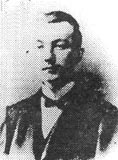
fig. 12 |
In
1914, in order to be able to show "expert care" of the archaeological
collections, which was required by a newly announced law on excavations,
the Mielżyński Family Museum employed an archaeologist educated
in Berlin under the tutelage of Gustav Kossinna. He was Józef
Kostrzewski ( fig. 12), who in 1914 defended
his doctorate, and as early as 1918 qualified as a professor in
Lwów. Throughout the whole of the war he spread the regenerated
scientific work, re-ordered the collections, also revived the
archaeological Commission, and in 1916 established the Museum
Society |
(for the support of the Mielżyński
Family Museum). After 10 months activity, that organisation had
500 members and an income of 7,500 marks; in 1918 the membership
roll rose to 850. The Society published its own magazine -
Museum Notes (Zapiski Muzealne). Initially there were some
difficulties with examination of the excavations, for which it
was necessary to have consent, yet thanks to the intervention
of Ludwig Kaemmer ( fig. 11), the director
of the Kaiser Friedrich Museum, this privilege Kostrzewski received,
and shortly extended the surface examinations and also
the excavation research. In 1917 he |

fig. 11 |
published Manifesto on the Inventorisation
of Prehistoric Relics (Odezwa w sprawie inwentaryzacji zabytków
przedhistorycznych), together with a questionnaire, marked for
the clergy and landowners (100 replies were received). The collapse
of Prussia and regaining of independence was greeted by Polish
archaeology in Wielkopolska as a dynamic science and ready to
join the scientific structure of the young Polish state, and not
in the last place.
2.3.2.
German archaeology 1885-1918: period of equality 1885-1903; period
of domination 1904-1914; period of collapse 1915-1918
In the eighth decade
of the nineteenth century German politicians were ever better
orientated that written and archaeological sources might be used
to force the concept of "many centuries old" settlement of the
Wielkopolska territory by Germans, identified unambiguously with
Germany, and thus of their right to these provinces. Quickly therefore
the majority of the archaeology culture was Germanised, especially
these young ones appearing on the territory of Wielkopolska. What
was difficult to Germanise was all ascribed to people long dead,
but also "Indo-German". In this way it would be inculcated into
the Germans freshly arriving in Wielkopolska that the seizure
of Poznań by Prussia was nothing else but a return to an earlier
part of the Fatherland and new German inhabitants
|
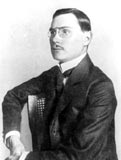
fig. 13 |
should not feel foreign here.
The Slavs took over land deserted willingly by the Germans, but
their stay on the Warta was fundamentally an insignificant "episode"
in history. This taking over the ownership of the history of the
province bore fruit in a sudden surge in German private and school
collections. Of how many there were in the 'eighties of the nineteenth
century, we know several score collectors (certainly there were
more), that were listed by Erich Blume ( fig.
13) in 1908 in a catalogue of collectors (MAP-A-dz-31) containing
at least several hundred entries and the majority of |
the names are German.
As mentioned above,
the opening of the permanent exhibition in the Polish Mielżyński
Family Museum encouraged the Germans to found the competing German
Historical Society of the Province of Poznań in 1885, whose main
aim was to establish a Provincial Museum of a decidedly German
character. With the initiative of employees of the State Archive,
in 1885 a Society that was competitive toward the Poznań Society
of Friends of Science was established to examine the past of the
province. Historische Gesellschaft had its offices in the State
Archive on Przemysław's Hill. The causes for creating both organisations
as clarified in communications addressed to German settlers in
1888: HG was to illuminate the history of the province by scientific
work and through the collection of historic relics. German inhabitants
could no longer remain behind the Poles, especially as from the
early medieval period only a small percent of Germans, and yet
their earlier "historic right" to these lands should not be forgotten.
The basic tasks of HG
were: historical research, including the history of art and culture,
the architecture of the province and numizmatology (in order to
prove that the majority of mint craftsmen were of German origin);
to take note in their publication of the results of allied scientific
research, being into areas such as geography, folklore, the study
of language, care of historic architecture, art, monuments, etc.
by their cataloguing and description. A library was to be assembled
and archives, historic art collected and first and foremost archaeology
and numismatic collections and research. When the Provincial Museum
would be opened, then the collections of the German Historical
Society should be transferred as the beginning of the museum collection.
At the beginning many
state officials were members of HG, so were two journalists (Bode
and Fontane), the manufacturer Gutmann, the banker N. Hamburger,
the merchant W. Kantorowicz, Rector Kutzmann, directors (Meinertz,
Nötel) and teachers (Fahle, Pfuhl, Plehwe) of the secondary schools.
The chairmen of the organisation were automatically appointed
by the President of the Province of Poznań (W. Barster, von Günther,
R. von Zedlitz und Trützschler, H. von Wilamowitz-Moellendorff,
R. von Bitter) and it was they who decided the main line of activity.
The works were in fact conducted by the vice-chairmen. The treasurers
were most frequently people connected with business. The new organisation
published its two own magazines Zeitschrift der historischen Gesellschaft
für die Provinz Posen (years 1885-1914) and Historische Monatsblätter
(1900-1923).
Due to gaining the membership
of highly placed persons, the German Society assured itself the
financial support of local government and the support of the Berlin
Ministry of Education (it transferred to them copies of books
from the Royal Library in Berlin etc.). The subsidies received
enabled them to publish their own magazines and purchase more
valuable items for their collections. After joining the German
National Union of Historic and Antiquarian Societies (Gesamtverein
der deutscher Geschichts- und Altertumsvereine) in 1888, the Poznanian
organisation was entrusted with organising the convention of the
German national organisation as mentioned earlier. Among about
3 thousand artefacts, which HG collected up to 1894, 2/3 was archaeological
relics. The basis of the collection consisted of private collections
donated by private individuals, though they also conducted their
own excavations (by e.g. R. Prümers, F. Schwartz - Wilhelm's son,
H. Hockenbeck, P. Tietz, B. Florschütz). HG also cooperated with
government offices and was involved with education. On the commission
of the Ministry in 1893, a cycle of briefings was announced for
the teachers in state primary schools, to interest them in archaeology
and encourage them to collect historic relics. They approached
the Police Commissioners with a request for mediation in the transfer
of relics. In this way, by the schooling of teachers, for the
first time it was attempted to join official archaeology to the
school education system. Another action of HG in 1893 was the
organisation of the celebrations (Gedenkfeier) marking the hundredth
anniversary of the partition of Poland. In 1889 they succeeded
at last in obtaining the decision of the provincial authorities
in the matter of establishing the Provincial Museum and National
Library. In 1892 for the needs of both institutions they received
the former building of the General Command, located on the site
of today's main building of the National Museum. In 1893 the announcement
of the opening of both institutions was made, and in 1894 the
collections of the German Historical Society were accepted by
the management of the province. The opening of the Museum-Library
(Provincial Museum) took place in October 1894, the former archive
assistant and ardent member of the Historical Society, Dr Schwartz
was appointed Commissioner Director of both institutions. From
the 1 st of April the museum establishment was included in the
establishment of provincial officials. Though numerically the
archaeological collections dominated the museum collection, a
separate position of archaeologist was not envisaged, but in fact
this role was filled by director F. Schwartz, educated as a child
in the school of his father, Wilhelm. In truth official support
assured the Provincial Museum markedly better development conditions,
but organisationally and qualitatively the institution was comparable
with Mielżyński Family Museum. However comparison of the collections
gave the advantage to the Poznań Society of Friends of Science.
The Provincial Museum had assembled many items, which even today
would meet little demand even on a "flea market"; this resulted
in a mixing up chambers of memorabilia and departments of examples
of industry. The museum inventory was adapted to works of art,
whilst being inadequate for archaeological collections. A catalogue
of relics was not kept and consequentially care of part of the
collections became mixed.
For greater achievements
the Provincial Museum needed to take in private collections of
the zealous TPNP member, Koehler ( fig. 5)
in 1901 (the initiator was Prof. G. Kossinna). Acceptance of the
whole collections quickly caused overfilling of the chambers received.
In 1898 an application was made to build a new building. Maintaining
a large museum and its equipment was a however a considerable
burden to the province, because of which, Senior Mayor Witting
and Regional Governor von Dziembowski in the name of the Provincial
Council negotiated with government over the principle of subsidy.
On the 17 th of January the Prussian Minister of Finance speaking
in parliament emphasised that among the projected tasks of the
Provincial Museum and Royal Academy was the strengthening of Germanness
and the German national consciousness. On the 25 th of February
1899 a contract was signed concerning government subsidies of
875,000 marks for construction of a new museum building, a grant
of 25,000 marks for the purchase of collections and an annual
50% subsidy of the running costs of the museum. In exchange the
museum had to carry out government policy in the protection of
relics and the government gained influence over the most important
appointments in the new institution. |
During
building in July 1901 Director F. Schwartz died unexpectedly aged
37 and the position remained unfilled. Next year the Provincial
Museum was renamed Kaiser Friedrich Museum (the patron was Friedrich
III, son of Kaiser Wilhelm I, known for liberal views and distaste
for Chancellor Bismarck). The institution was simultaneously one
of the most modern museum buildings in Europe, finished in 1903.
Only then was Prof. Ludwig Kaemmerer ( fig.
11), a known author on the history of art, appointed
director a custodian of the store
of archaeological |
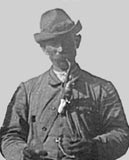
fig. 14 |
collections, Wilhelm Thamm ( fig.
14) was also employed. The Museum was to be firstly a "school
museum"; therefore educational activity took pride of place. The
prehistoric exhibition was designed by Dr. Erich Schmitt, a senior
teacher from Bydgoszcz, classifying by culture, epoch and territory.
The formal opening of KFM and its exhibitions occurred on the
5 th of October 1904. From then on one might speak of
a new era in museum activity in Poznań, which took on a very modern
form.
From 1904 as well as
permanent exhibitions there were so called "study rooms", where
young people could have direct contact with the relics. Temporary
exhibitions were also prepared. Annually 60-88 thousand people
visited KFM, yet it is not known what proportion visited the prehistoric
exhibits.
The Kaiser Friedrich
Museum took over from the Provincial Museum the rich archaeological
collections. To keep the documentation in proper order, the so-called
District Archive (Kreisarchiv) was founded, gathering all information
on new discoveries within the district. For lack of a specialist,
the collections themselves in the first few years of KFM were
practically scientifically unattended. The store custodian, W.
Thamm, organised them under the supervision of G. Haupt and K.
Simon - cultural historians, but his catalogue of archaeological
relics was markedly inferior to that of Mielżyński Family Museum.
The activity of Thamm is much better regarded concerning conservation
of relics. He and equally his custodians took part in archaeological
intervention, averaging about 20 days per year.
Because none of the
employees at KFM knew prehistory well, the greatest emphasis was
laid on the functioning of exhibitions, gathering private collections
and popularising archaeology with protection of relics. Numerous
lectures were organised for teachers' seminars and methodology
conferences. Individual lecture cycles were run for interested
people. As a result of this systematic educational action ever
more people became interested in archaeology and spread the idea
of protecting historic relics.
In 1906 the Museum Commission
recommended the employment of an archaeologist, and when in 1908
a vacancy occurred E. Blume ( fig. 13),
was employed, who although he just finished his studies, rejoiced
in the excellent opinion of his promoter. Prof. G. Kossinna, he
was known also in Wrocław, and the subject of his doctorate also
concerned Wielkopolska. It was proposed that he start work at
KFM as an auxiliary, and when he wrote his doctorate and proved
himself in practice - he might be appointed permanent scientific
assistant. With the employment of Blume in mid 1908 the day of
the amateur in Poznań archaeology was ended forever.
Within four years work
in Poznań, E. Blume finished his doctorate and had it printed,
organised the archaeological exhibition form the private collections
for the occasion of the already mentioned 40 th Anthropological
Congress, published a fully scientific catalogue of these exhibitions,
taught W. Thamm an excellent excavation technique, introduced
a new type of catalogue card, which practically unchanged is used
in Poznan to this day, grew up a new type of registration card,
re-sorted the catalogue and defined the chronology of significant
parts of Poznań relics (ordered in 5 groups: I - Palaeolithic
and Mesolithic, II - Neolithic - Early Bronze Age, III - Lusatian
- "Thracian and Illyrian" Culture, IV - "German Cultures", V -
Slavic- Medieval Period). Blume also conducted intensive examination
of the terrain - surface and excavation. Amongst the most interesting
sites were the cemeteries in Poznań-Golęcin and Poznań-Sołacz,
or also at Luboń-Lasek, Puszczykowo-Niwka and Siedlemin. Blume
had the interesting idea of printing a questionnaire in 1912,
together with a communiqué and instructions, which asked landowners
and teachers for information on sites of earlier discoveries.
The museum workers placed great emphasis on popularisation, announcing
readings, lectures and so on. Blume himself published 15 studies,
two of them considerable.
This enormous momentum
in archaeological research was broken by the sudden death of Blume
in September 1912. Johannes Richter took his place from the Silesian
Museum of Artistic Craftsmanship and Antiquities in Wrocław. Yet
the new employee was in no regard the equal of E. Blume and German
archaeology in Poznań started to visibly lose impetus.
After release from military
service, on 21 st of November 1918, Richter once more
began work at the Museum, but only formally, for the museum premises
had been taken over by the army. He took leave and travelled to
Wrocław. Meanwhile the Wielkopolska Uprising broke out. The directorate
attempted to induce Richter to return, who however requested leave,
because "a highly advanced nervous ailment". In February 1919
Richter still had not returned, explaining himself with a ministerial
prohibition, later falling ill and applying for retirement, until
the already meanwhile Polish directorate of the now Wielkopolska
Museum, dismissed him. Meanwhile all the German museum employees
were dismissed, but J. Kostrzewski ( fig.
12) wished to make an exception for the already distinguished
excavation specialist, as Thamm ( fig. 14)
had become. This idea did not bear fruit because of the reluctance
of Thamm himself, who fell victim to the then fashionable, among
German officials, "nervous exhaustion" and later went to Germany,
taking with him his own rich archive and relics, mainly flints.
Together with the abolition of German institutions and the departure
from Poland of all the German specialists - ended the era of two
archaeologies in one place. To a limited degree it was taken up
by some German historian amateurs, of whom the best known was
Walther Maas, author of archaeological maps of Wielkopolska, published
in Polish in the Polish Archaeological Review in 1928. |
The
rivalry between Polish and German lovers of antiquities brought
results, which were equally negative and positive:
- negative - increase in nationalism, exploitation of advantage,
use of archaeology for short term political aims, especially
visible on the German side
- positive - the gathering of large collections, increase
in interest in archaeology and protection of historic relics,
attempts to perfect research methodology, the preparation
of a sufficiently effective model for the protection of historical
relics, the teacher taught, the priest or pastor appealed
to conscience and the policeman pursued from the authorities.
|
Bibliography:
Dzieje Poznania
1994 Rozwój liczebny i rozmieszczenie ludności, [in:] Dzieje
Poznania II/1, Warszawa-Poznań,
Grześ B., Kozłowski J., Kramski A.
1976 Niemcy w Poznańskiem wobec polityki germanizacyjnej 1815-1920,
Poznań
Kaczmarek J.
1996 Organizacja badań i ochrony zabytków archeologicznych
w Poznaniu (1720- 1958), Poznań
Łukasiewicz D.
1995 Czarna legenda Polski. Obraz Polski i Polaków w Prusach
1772-1815, Poznań
Kmieciński J.
1991 Nacjonalizm w germanoznawstwie niemieckim w XIX i początkach
XX wieku, AB, vol. X. Łódź
Kostrzewski J.
1949 Dzieje polskich badań prehistorycznych, Poznań
Kaemmerer L.
1904 Das Kaiser Friedrich Museum, seine Geschichte und Organisation,
Historische Monatsblätter V, pp. 36-47
Sadowski J. N.
1877 Die Handelsstraßen der Griechen und Römer durch das Flußsgeniet
der Oder, Kraków |
|







